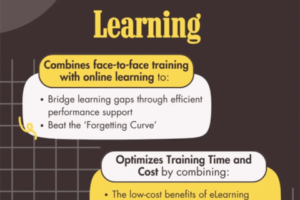
Adaptive Leadership Training: A Closer Look
Adaptive Leadership Training: A Blueprint For Building Resilient Leaders
As every Instructional Designer knows, there are many ways to design and deliver training. A common breakdown groups programs by subject:
- Core business training
- Professional development and skills training
- Compliance and safety training
- Culture training
This breakdown of types of training programs by subject works, but it’s hardly unique. The question is whether it’s the most effective for today’s leaders. With attitudes changing across the board, the older approaches often don’t cut it anymore.
The Adaptive Leadership Approach
Rather than offering leadership training courses based on past successes, an adaptive design can address changing needs more effectively. When it comes to professional development, the adaptive approach can:
- Develop advanced techniques to motivate their teams.
- Strengthen self-awareness and emotional intelligence to manage people more effectively.
- Learn quickly in short timeframes to maximize time with their teams.
Putting The Abstract Into Practice
Adaptive leadership training lays the groundwork for practical application. One of the most popular examples of employee development plans is the personalized approach.
The practical framework adaptive training provides helps leaders adjust their approaches as needed, keeping learners more engaged.
A key tenet of this approach is encouraging others to solve challenges by delegating tasks. This “giving the work back” concept empowers employees and increases career satisfaction.
Adaptive Leadership In Action
At its core, adaptive leadership training generates opportunities for Instructional Designers to create engaging content quickly. Through scenario-based exercises, trainers give leaders opportunities to address challenges in new ways.
This training enables leaders to navigate complexities without relying on existing or traditional solutions. Instead, problems are solved through quick decisions based on the specific details of the situation.
Using skills gained from adaptive training exercises, leaders can triage and solve issues fast. This also fosters a company culture of resilience.
From Concept To Blueprint: Core Design Principles For Adaptive Training
To turn this concept into a learning blueprint, Instructional Designers need design principles that prioritize process over content.
Principle 1: Scenario-Based Learning Instead Of Content Dumping
Skip modules like “The 5 Styles of Communication.” Instead, build immersive, branching scenarios with gray-area problems. Tools like iSpring Suite are specifically designed to help create this kind of adaptive content.
- Ditch: A multiple-choice quiz on conflict resolution.
- Build: A scenario where a leader mediates a conflict between a veteran employee and a new hire who wants to implement AI tools that could make the veteran’s role obsolete. There is no “right” answer, only trade-offs and consequences. Each choice affects team morale, project timelines, and trust, showing learners the systemic impact of their decisions.
Principle 2: Embrace Productive Struggle
In Instructional Design, the instinct is to minimize friction and provide immediate feedback. For adaptive skills, though, the opposite is needed. The goal is learning to tolerate ambiguity.
- Ditch: A pop-up giving the “correct” answer right after a decision.
- Build: Activities with delayed feedback, ambiguous data, and conflicting stakeholder opinions. Let learners debate with peers and sit in the uncertainty. The debrief, why they chose a path and what they learned, becomes more valuable than the choice itself.
Principle 3: Encourage Radical Reflection And Self-Awareness
Adaptive work starts from within. A leader’s own biases, blind spots, and behaviors are often part of the system they’re trying to change.
- Ditch: Simple recall checks.
- Build: Private journaling prompts guided by questions such as: “What in your mindset is challenged by this scenario?” or “What authority are you afraid to lose here?” Use peer discussion boards not just to share ideas but to challenge each other’s assumptions in a structured, respectful way.
Principle 4: Build A Community Of Practice, Not Just A Class
Adaptive challenges can’t be solved alone. Training must break out of the LMS’s solitary confinement.
- Ditch: One-off, isolated training events that end with a certificate.
- Build: A social learning architecture. Use cohort-based models where leaders progress together. Create mentorship circles and ongoing “leadership labs” where participants bring real workplace challenges to get feedback and support from peers. The group becomes a lasting source of resilience.
Choosing The Right Option: How To Evaluate A Training Program
Adaptive leadership training isn’t a one-size-fits-all approach. A mix of different training options is never a bad thing. So how should L&D professionals decide which option is right for their organization?
The first step is to evaluate a training program against organizational goals and learner outcomes:
- Review the full capabilities of current solutions.
- Document what you have using a model like Kirkpatrick’s four-level training evaluation (reaction, learning, impact, and results).
- For a financial analysis, calculate ROI against program costs.
- Use a questionnaire to find out what learners want or need to know.
Beyond these basics, it helps to look at the bigger picture. A training program may check all the boxes on paper, but if it doesn’t fit your culture or have leadership support, it won’t stick. What works well in one team might flop in another, so think about how scalable and flexible the program really is, especially if your workforce is hybrid or global.
It also pays to see how your programs compare with industry benchmarks or peer organizations. Are you ahead, on par, or falling behind? These insights can highlight hidden gaps and spark new ideas for improvement.
Most importantly, remember that evaluation isn’t a one-and-done task. Use quick surveys, feedback loops, and performance data to keep programs fresh and relevant. The goal is not only to be effective today but also to provide training that will adapt as your people and business change. That way, learning becomes less of a checkbox and more of a growth engine.
In Conclusion
It’s no secret that many organizations want the same outcomes from their training programs: expanding internal knowledge, refining skills, developing current and future leaders, and meeting compliance demands. More and more organizations are turning to adaptive approaches. As discussed, the key is aligning training with real goals and culture.
Identifying challenges and applying scenario-based training often accelerates successful outcomes. Adaptive leadership training drives collaborative team dynamics, promotes innovative solutions, and helps everyone work through challenges together.
Source link




